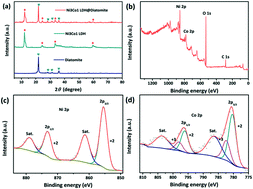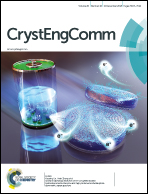Crystal morphology evolution of Ni–Co layered double hydroxide nanostructure towards high-performance biotemplate asymmetric supercapacitors†
Abstract
Hierarchical three-dimensional (3D) porous structures of nickel–cobalt layered double hydroxide (LDH) are grown on diatomite biotemplate via one-step hydrothermal method. The crystal morphologies and properties of the materials can be controlled by adjusting the ratios of Ni–Co ions concentration during the reaction process. Increasing the proportion of nickel causes the morphology of the Ni–Co LDHs to change from nanowires to nanosheets, and improves the electrochemical performance of Ni–Co LDH@diatomite. The Ni3Co1 LDH@diatomite composites exhibit an ultrahigh specific capacitance of 514 F g−1 at a current density of 1 A g−1 and have 94.2% capacitance retention after 5000 cycling tests at a current density of 2 A g−1. Interestingly, the assembled Ni–Co LDH@diatomite@nickel foam//AG asymmetric supercapacitor (ASC) achieves a maximum energy density of 56 Wh kg−1 at a current density of 1 A g−1.



 Please wait while we load your content...
Please wait while we load your content...